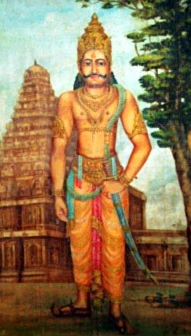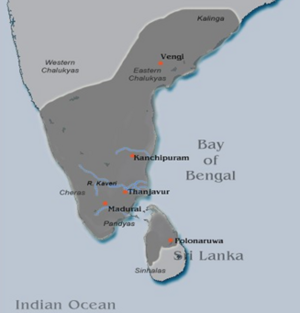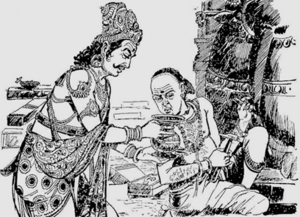Talk:Rājārāja Chola I (985–1014 CE)
By Vishal Agarwal
The Cholas were among the most ancient ruling dynasties of South India. They are first mentioned in the Tamil Saṅgam literature, which dates back over two millennia. Two of the most celebrated emperors of this lineage were Rājarāja Chola I and his son Rājendra Chola I.
Rājarāja Chola I initially declined the throne after the death of his father, Parāntaka II, as his paternal uncle desired to rule. Out of respect, Rājarāja allowed him to ascend the throne. Deeply moved by this gesture, the uncle designated Rājarāja as his successor, and seventeen years later, Rājarāja Chola I became king.
Under his rule, the Chola Empire expanded greatly. He subdued most of South India, conquered Siṃhaladvīpa (Sri Lanka), and extended his navy’s influence to the Maldives. Though a devotee of Śiva, Rājarāja was noted for his religious tolerance toward Vaiṣṇavas and Buddhists alike.
In 1010 CE, he completed the construction of the Bṛhadīśvara Mandir at Tañjāvūr, one of the grandest architectural achievements in Indian history. The temple’s tower rises 216 feet and is capped by a single granite block weighing several tons. The Śivaliṅga within the sanctum is two storeys high, symbolizing the monumental scale of Chola devotion and craftsmanship.
Story: The Humble King and the Sculptor
One day, while visiting the temple construction site, the king observed a sculptor at work. Mistaking the king for his attendant, the sculptor said,
- “Boy, make me a pān.”
Rājarāja quietly rolled betel leaves with areca nuts and offered them. The sculptor, unaware of his true identity, accepted the pān. After some time, he instructed,
- “Bring me the spittoon.”
The king obediently complied. When the sculptor finally looked up and recognised that his “servant” was the emperor himself, he was horrified and fell at the king’s feet, begging forgiveness. Rājarāja graciously raised him and said with a smile,
- “It was my honour to serve a great sculptor like you. Do not be troubled; I take no offence.”
This story, preserved in temple lore, reflects the king’s humility and reverence for artisans.
Story: The Devotion of Ālagi
Among those who contributed to the temple’s construction was an elderly woman named Ālagi, who lived near the site. Though frail and poor, she wished to serve in her own way. Each day, she prepared spiced buttermilk and personally offered it to the exhausted labourers and sculptors working in the scorching sun. Her simple act of compassion revived their strength and morale.
When the temple neared completion, Ālagi desired to make an offering. She requested the chief mason to use a single granite stone from her backyard in the structure. While others mocked her humble gift, the mason, moved by her devotion, agreed and placed it as a coping stone at the temple’s summit.
Six years later, as the magnificent temple stood ready, an auspicious day was fixed for its consecration. On the eve of the ceremony, Bhagavān Śiva appeared to Rājarāja in a dream, saying,
- “I shall dwell beneath the shelter offered by Ālagi.”
Awakening in wonder, the king sent for her the next morning. She was found living in a modest hut, unaware of the divine acknowledgment. When Rājarāja learned of her years of selfless service and her modest donation, he went to her hut with folded hands and brought her personally to the temple.
Before the assembled congregation, the emperor honoured Ālagi and proclaimed:
- “The Lord is pleased not by wealth, but by devotion. Ālagi’s simple act of service has earned divine grace greater than all the riches bestowed here.”
Ālagi accepted the honour with humility and spent the remainder of her life serving the temple and its workers, becoming immortalized in Chola tradition as a symbol of pure devotion (bhakti) and selfless service (sevā).
Rājarāja Chola I and the Preservation of the Tamil Bhakti Tradition
Another major contribution of Rājarāja Chola I was his effort to preserve and compile the devotional hymns of the Nāyaṉmār saints. During his reign, he commissioned scholars and temple priests to collect their sacred compositions, which were primarily written in Tamil. Some members of the priestly community, who preferred Sanskrit, initially opposed the project because they believed that sacred writings should be composed only in Sanskrit.
Through this initiative, Rājarāja Chola I affirmed that divine praise and spiritual wisdom were not confined to any single language. He declared that the bhakti of saints who glorified Bhagavān Śiva in Tamil was equally sacred. Under his guidance, long-preserved manuscripts that had been locked in temple repositories were brought out and compiled with care. These hymns were arranged into nine volumes, and about a century later, additional compilations brought the total to twelve.
Collectively, these twelve volumes came to be known as the Tirumuṟai, revered as sacred texts by Tamil-speaking devotees of Śiva. The Tirumuṟai became foundational to the Śaiva Siddhānta tradition and to the temple culture of South India.
Until the time of Rājarāja Chola I, temples primarily enshrined images of devas and devīs. By his initiative, temples began to include mūrtis of revered saints alongside the deities, symbolizing the union of bhakti and divine grace. This practice strengthened the roots of Hindu dharm in the Tamil region and enriched the cultural and spiritual life of South India.



